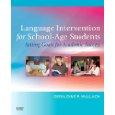Language Intervention Review. Intervention in Language Arts
Language Intervention review
 The thing I like most about this book is that Wallach playfully (never harshly) questions some older language intervention attitudes and methods.
The thing I like most about this book is that Wallach playfully (never harshly) questions some older language intervention attitudes and methods.
The author points out that many current work practices speech pathologists use are often based on theories that have gone unchallenged for many years.
Geraldine Wallach draws upon an abundance of current language research and presents best practice methods in a very convincing way.
The author very cleverly uses real case studies of language impaired children to demonstrate
her views on text-based intervention.
Some of the descriptions used by Geraldine Wallach to describe language disorder are a fine example of science
writing, and help to communicate the isolating effect language impairment can have on a school-age student.
I particularly enjoyed the analogy that having a language disorder is similar to learning a new language, such as French. And how the absence of context makes the task of learning language much more difficult.
Wallach contrasts the difficult situation of learning French in a social setting ( a dinner party) to learning French in a more familiar and comfortable setting - playing a game with which the reader is familiar (Monopoly).
The French language analogy provides a neat description of what it might be like to be a child with language impairment,
and how difficult a child may find it to learn new language concepts without a supporting context.
Geraldine Wallach is a big advocate for teaching language impaired children within a recognizable context. That is, using
text - both fiction and non fiction - as a contextual platform from which to construct new language knowledge.
This is a book I highly recommend for both students and experienced clinicians.
Return from Language Intervention review to Speech Pathology Books
Enjoy this page? Please pay it forward. Here's how...
Would you prefer to share this page with others by linking to it?
- Click on the HTML link code below.
- Copy and paste it, adding a note of your own, into your blog, a Web page, forums, a blog comment,
your Facebook account, or anywhere that someone would find this page valuable.
|